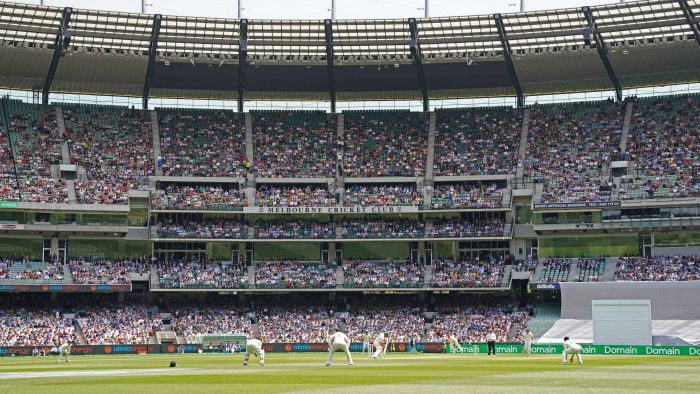In a New York minute, the joyous news that it was possible 25,000 people could attend each day of the Boxing Day Test degenerated into a squabble about the allocation of cricket’s golden tickets.
On one side are the Veruca Salts of the MCC Members demanding value for their subscriptions after an AFL-free winter; on the other the Augustus Gloops of the outer whose presence lends the occasion its boisterous soundtrack as the beer cup snakes lengthen.
The difficulty of determining which of the usual 80,000 backsides will occupy the 25,000 suitably distanced seats is further complicated by the entitlements of the Mike Teavees of the corporate sector.
Yet rather than unseemly, this familiar cultural clash about access to a major Melbourne sporting event seems as comforting as the roar that will echo around the MCG when the first Boxing Day wicket falls.
Even before the old Members Pavilion was replaced, the MCG was largely defined by its vast capacity and consequent acoustics rather than its now mostly functional grandstands and unremarkable aesthetic.
Crowds of 25,000 that would fill smaller venues rattle around in the cavernous confines of the ‘G where thousands of empty seats can create the false impression a relatively well-attended contest has been forsaken.
But assuming Melbourne’s next wave is Mexican and not COVID-related, on Boxing Day the MCG will for once seem quarter-filled rather than three quarters empty despite the gaps between patrons.

Thus the second Test against India will be a symbolic moment of sports viewing liberation in the self-proclaimed sporting capital; the first “mass” celebrated in nine months in Melbourne’s sporting cathedral since the wonderful Women’s T20 World Cup viewed by 86,000 spectators preceded a winter in sporting purgatory.
Competing forces will argue Boxing Day crowds are possible because of the stout efforts of Victorian Government officials who have reduced case numbers from a Bradmanesque average to a more manageable McGrathian number, despite the bungling of the same officials or in spite of the jeering that has come across state borders.
But however you spin it, Boxing Day 2020 presents as not merely a highly anticipated Test against a richly talented Indian men’s team. It will usher the return of some kind of sports viewing normality to a city where major events were, before the pandemic, considered a right rather than a privilege.
Melbourne desperate for sport
While Melburnians have slowly become accustomed to the deprivation of their sports viewing rituals throughout the winter, two abject experiences near the tail end of the COVID-19 drought will make Boxing Day even sweeter.
Last weekend’s AFL grand final in Brisbane was — quite literally — a glowing success, given the gladiatorial contest and the energetic, laser-lit half-time performance (as opposed to the rather tame pre-game karaoke).
In a year when merely staging games required the kind of logistics traditionally reserved for military invasions and Rebecca Judd’s Christmas parties, the Gabba grand final provided far more than a pale imitation of the real thing.
But the night timeslot meant there was an almost funereal atmosphere in locked-down Melbourne throughout the day, with Richmond Tigers fans confined to their lairs and no pre-game partying possible with pubs, restaurants and cafés closed, and household visits severely limited.




This made it impossible to assess what a night or twilight grand final would be like in Melbourne — although should a 7:30pm start be preceded by large gatherings in hotels and backyard barbecues, I would suggest the correct answer is “drunk”.
While those in other states might bemoan Melbourne’s sense of AFL grand final entitlement, the long pause was a kind of requiem for a city mourning its lost sporting soul.
Melbourne Cup day will present differently. There will be no soapie stars strutting in marquees or sozzled blokes in nun’s habits and footy shorts on the Flemington lawns, but there will be the chance to congregate in small numbers to watch the race off-course.




Quite understandably this Melbourne spring carnival has failed to gain momentum. Never has it been more apparent that it is the social rituals rather than the racing itself that elevates the month-long event.
So where usually the Melbourne Cup is the exclamation mark at the end of a series of racing-themed parties, this one will be somehow detached and discordant.
Cricket, however, has found its summer rhythm. The women’s internationals and WBBL have enjoyed some welcome clean air, while the Sheffield Shield has already thrown Western Australian prodigy Cameron Green into the Test team mix.
In that regard, the tour game between India and Australia A in Sydney could be as useful for the home team in finalising selection as it is for the tourists in aiding acclimatisation.
The now unusual back-ending of Test matches into the new year — hosted by Sydney (January 7-11) and Brisbane (January 15-19) — is also welcome for those whose idea of holiday heaven is a poolside banana lounge and ABC Grandstand cricket on the radio.
It all seems nice and soothing, and normal — nothing more so than the prospect of sports-hungry Melburnians fighting tooth and nail for the big game tickets they consider their birthright.
Offsiders will have analysis of all the major sports events and stories, including a special Melbourne Cup preview, on Sunday at 10:00am on ABC TV.







